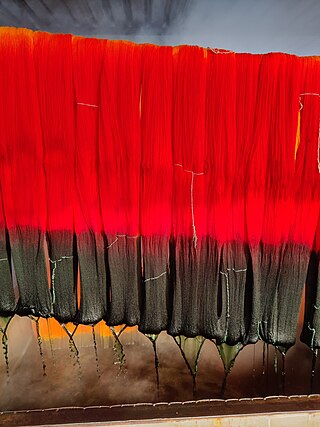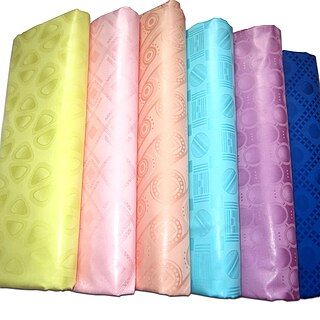Related Research Articles

Tie-dye is a term used to describe a number of resist dyeing techniques and the resulting dyed products of these processes. The process of tie-dye typically consists of folding, twisting, pleating, or crumpling fabric or a garment, before binding with string or rubber bands, followed by the application of dye or dyes. The manipulations of the fabric before the application of dye are called resists, as they partially or completely prevent ('resist') the applied dye from coloring the fabric. More sophisticated tie-dye may involve additional steps, including an initial application of dye before the resist, multiple sequential dyeing and resist steps, and the use of other types of resists and discharge.

Shibori is a Japanese manual tie-dyeing technique, which produces a number of different patterns on fabric.
Ikat is a dyeing technique from Southeast Asia used to pattern textiles that employs resist dyeing on the yarns prior to dyeing and weaving the fabric. In Southeast Asia, where it is the most widespread, ikat weaving traditions can be divided into two general groups of related traditions. The first is found among Daic-speaking peoples. The second, larger group is found among the Austronesian peoples and spread via the Austronesian expansion to as far as Madagascar. It is most prominently associated with the textile traditions of Indonesia in modern times, from where the term ikat originates. Similar unrelated dyeing and weaving techniques that developed independently are also present in other regions of the world, including India, Central Asia, Japan, Africa, and the Americas.

Dyeing is the application of dyes or pigments on textile materials such as fibers, yarns, and fabrics with the goal of achieving color with desired color fastness. Dyeing is normally done in a special solution containing dyes and particular chemical material. Dye molecules are fixed to the fiber by absorption, diffusion, or bonding with temperature and time being key controlling factors. The bond between the dye molecule and fiber may be strong or weak, depending on the dye used. Dyeing and printing are different applications; in printing, color is applied to a localized area with desired patterns. In dyeing, it is applied to the entire textile.

Bògòlanfini or bogolan is a handmade Malian cotton fabric traditionally dyed with fermented mud. It has an important place in traditional Malian culture and has, more recently, become a symbol of Malian cultural identity. The cloth is exported worldwide for use in fashion, fine art and decoration.

Bandhani is a type of tie-dye textile decorated by plucking the cloth with the fingernails into many tiny bindings that form a figurative design. Today, most Bandhani making centers are situated in Gujarat, Rajasthan, Sindh, Punjab region and in Tamil Nadu where it is known as Sungudi. It is known as chunri in Pakistan. Earliest evidence of Bandhani dates back to Indus Valley civilization where dyeing was done as early as 4000 B.C. The earliest example of the most pervasive type of Bandhani dots can be seen in the 6th century paintings depicting the life of Buddha found on the wall of Cave at Ajanta. Bandhani is also known as Bandhej Saree, Bandhni, Piliya, and Chungidi in Tamil and regional dialects. Other tying techniques include Mothra, Ekdali and Shikari depending on the manner in which the cloth is tied. The final products are known with various names including Khombi, Ghar Chola, Patori and Chandrokhani.
The Coty American Fashion Critics' Awards were created in 1942 by the cosmetics and perfume company Coty to promote and celebrate American fashion, and encourage design during the Second World War. In 1985, the Coty Awards were discontinued with the last presentation of the awards in September 1984; the CFDA Awards fulfill a similar role. It was casually referred to as "fashion's Oscars" because it once held great importance within the fashion industry and the award ceremonies were glitzy galas.

Kasuri (絣) is the Japanese term for fabric that has been woven with fibers dyed specifically to create patterns and images in the fabric, typically referring to fabrics produced within Japan using this technique. It is a form of ikat dyeing, traditionally resulting in patterns characterized by their blurred or brushed appearance.

Adire (Yoruba) textile is a type of dyed cloth from south west Nigeria traditionally made by Yoruba women, using a variety of resist-dyeing techniques. The word 'Adire' originally derives from the Yoruba words 'adi' which means to tie and 're' meaning to dye. It is a material designed with wax-resist methods that produce patterned designs in dazzling arrays of tints and hues. It is common among the Egba people of Ogun State.
Rit is a brand of dye first sold in 1916. As of 2013, it is owned by Phoenix Brands.

Leheriya is a traditional style of textile tie dye from Rajasthan, India. Its designs are inspired by the natural wave(leher) patterns formed by the wind blowing across the desert sands of western Rajasthan. The craft is exclusive to Rajasthan, with its main centres being the cities of Jaipur and Jodhpur.

Giorgio di Sant' Angelo (Jorge Alberto Imperatrice), commonly known as Giorgio Sant'Angelo, (1933–1989) was an Italian/Argentinian fashion designer based in the United States. He was known for creating ethnic-inspired looks early in his career, for which he won the prestigious American Coty Fashion Critic's award in 1968 and in 1970. Using fabrics like tie-dyed chiffon, leather and cotton, he created romantic clothing that reflected the hippie culture of the era. But his innovative use of knitwear, which he continuously developed throughout his career, was often his signature and was an influence on other designers.
Cadoro, or Cadoro Jewels Corporation, was a Manhattan-based jewelry company founded in 1954 by Steven Brody and Daniel Stoenescu, specialising in fashionable costume jewelry sold via department stores such as Neiman Marcus and Saks Fifth Avenue. The company closed in 1987 following Brody's retirement as president.
Bill Smith is an American fashion and jewelry designer who was the first black recipient of a Coty Award for his designs. He has designed for a number of companies, including costume jewelry for Coro and Richelieu, leather goods for Mark Cross, and furs for Ben Kahn, along with designing jewelry for Cartier.
Marty Ruza of "Ruza Creations"/"Elegant Belts" was an American designer of leather fashion accessories who won a Coty Award for jewelry design in 1970. He was described by the fashion journalist Eleanor Lambert as the "leader of the fringed leather and beads school".
Clifton 'Cliff' Nicholson is an American sculptor and jewelry designer.
Karen S. Hampton is an American textile designer, textile artist, and quilter. She creates works of art intended to hang on a wall, and "wearable art" including scarves and jackets. She lives in Evansville, Indiana.

Shweshwe is a printed dyed cotton fabric widely used for traditional Southern African clothing. Originally dyed indigo, the fabric is manufactured in a variety of colours and printing designs characterised by intricate geometric patterns. Due to its popularity, shweshwe has been described as the denim, or tartan, of South Africa.

Yūzen (友禅) is a Japanese resist dyeing technique where dyes are applied inside outlines of dyed or undyed rice-paste resist, which may be drawn freehand or stencilled; the paste keeps the dye areas separated. Originating in the 17th century, the technique became popular as both a way of subverting sumptuary laws on dress fabrics, and also as a way to quickly produce kimono that appeared to be painted freehand with dyes. The technique was named after Miyazaki Yūzen (宮崎友禅), a 17th century fan painter who perfected the technique. Miyazaki Yūzen's fan designs became so popular that a book called the yūzen-hiinagata was published in 1688, showing similar patterns applied to kosode. A fashion for elaborate pictorial yūzen designs lasted until 1692.

Bazin is a West African fabric with its origin in Europe imported in Mali, made from hand-dyed cotton, resulting in a damask textile known for its stiffness and vibrant sheen. It is primarily recognized as the most commonly used fabric for crafting a Boubou, a long, loose traditional outerwear worn by both men and women, particularly in West Africa.
References
- 1 2 3 4 5 Lady Fare (29 September 1970). "Bill Blass Named to Hall of Fame". The News and Courier. Retrieved 14 December 2012.
- ↑ McDowell, Colin (1984). McDowell's Directory of Twentieth Century Fashion. Frederick Muller. pp. 299–301. ISBN 0-584-11070-7.
- 1 2 Weinger, Erin (19 April 2008). "Fashions to tie-dye for". Tampa Bay Times. Archived from the original on April 25, 2008. Retrieved 14 December 2012.
- 1 2 3 4 5 "The Psychedelic Tie-Dye Look". TIME Magazine. 26 January 1970. Archived from the original on July 12, 2007. Retrieved 14 December 2012.(subscription required)
- 1 2 "Tying Up the Best Tie-Dyes in Beachwear". Look Magazine. 1971.
- ↑ Harris, Joann (Nov 22, 1970). "Small Outfits Make It Big In Tie-Dye". The Baltimore Sun. Archived from the original on February 1, 2013. Retrieved 14 December 2012.
- 1 2 Lambert, Eleanor (19 September 1970). "Ethnic Theme Monopolises Front Seat in Fashion". The News and Courier. Retrieved 29 November 2012.
- ↑ Hoffmann, Frank W.; William G. Bailey (1994). Fashion & merchandising fads . New York: Haworth Press. pp. 257. ISBN 1560243767.
